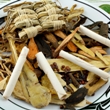Saiboku-to
Saiboku-to
Natural Standard Monograph, Copyright © 2013 (www.naturalstandard.com). Commercial distribution prohibited. This monograph is intended for informational purposes only, and should not be interpreted as specific medical advice. You should consult with a qualified healthcare provider before making decisions about therapies and/or health conditions.
Related Terms
Asian ginseng, Asian skullcap, ginger, herbal remedies, hoelen, jujube, Kampo, licorice, magnolia, minor bupleurum decoction, perilla, pinellia, TJ-96, ziao-chai-hu-tang.
Background
Saiboku-to is a Japanese herbal formula that is commonly used to treat asthma. Saiboku-to has been approved by the Japanese Health Ministry for the treatment of asthma. Saiboku-to has shown to decrease asthmatic inflammation in numerous trials as compared to placebo.
Saiboku-to contains bupleurum, hoelen, pinellia, magnolia, Asian ginseng, Asian skullcap, licorice, perilla, ginger and jujube. The combination of herbs is thought to have significant anti-inflammatory and anti-histamine effects.
Theory/Evidence
Saiboku-to has been approved by the Japanese Health Ministry for the treatment of asthma. Saiboku-to has shown to decrease asthmatic inflammation in numerous trials as compared to placebo. One trial found that saiboku-to affected platelet-activating factor. The platelet-activating factor (PAF) is a chemical mediator responsible for allergic and inflammatory responses. This study showed that patients who took this herb had significant decreases in the asthmatic inflammation they had previously suffered from. This suggests a possible mechanism of action for the herb.
There are also reports of saiboku-to being used for bronchitis, however, there is little evidence suggesting saiboku-to suggest any anti-infective properties.
Safety
The U.S. Food and Drug Administration does not strictly regulate herbs and supplements. There is no guarantee of strength, purity or safety of products, and effects may vary. You should always read product labels. If you have a medical condition, or are taking other drugs, herbs, or supplements, you should speak with a qualified healthcare provider before starting a new therapy. Consult a healthcare provider immediately if you experience side effects.
Taking saiboku-to and steroids together may increase the effects of steroids. This interaction was reported with the concurrent use of prednisolone and siaboku-to. Speak with a qualified healthcare provider before making any decision regarding herbal supplements.
Author Information
This information has been edited and peer-reviewed by contributors to the Natural Standard Research Collaboration (www.naturalstandard.com).
Bibliography
Natural Standard developed the above evidence-based information based on a thorough systematic review of the available scientific articles. For comprehensive information about alternative and complementary therapies on the professional level, go to www.naturalstandard.com. Selected references are listed below.
Naito A, Satoh H, Sekizawa K. Asthma as well as anxiety improved by the Kampo extract Saiboku-to. Eur J Intern Med. 2005 Dec;16(8):621. View Abstract
Nakamura T, Kuriyama M, Kosuge E, et al. Effects of saiboku-to (TJ-96) on the production of platelet-activating factor in human neutrophils. Ann N Y Acad Sci. 1993 Jun 23;685:572-9. View Abstract
Natural Standard: The Authority on Integrative Medicine. www.naturalstandard.com
Copyright © 2013 Natural Standard (www.naturalstandard.com)
The information in this monograph is intended for informational purposes only, and is meant to help users better understand health concerns. Information is based on review of scientific research data, historical practice patterns, and clinical experience. This information should not be interpreted as specific medical advice. Users should consult with a qualified healthcare provider for specific questions regarding therapies, diagnosis and/or health conditions, prior to making therapeutic decisions.
Updated:
March 22, 2017
